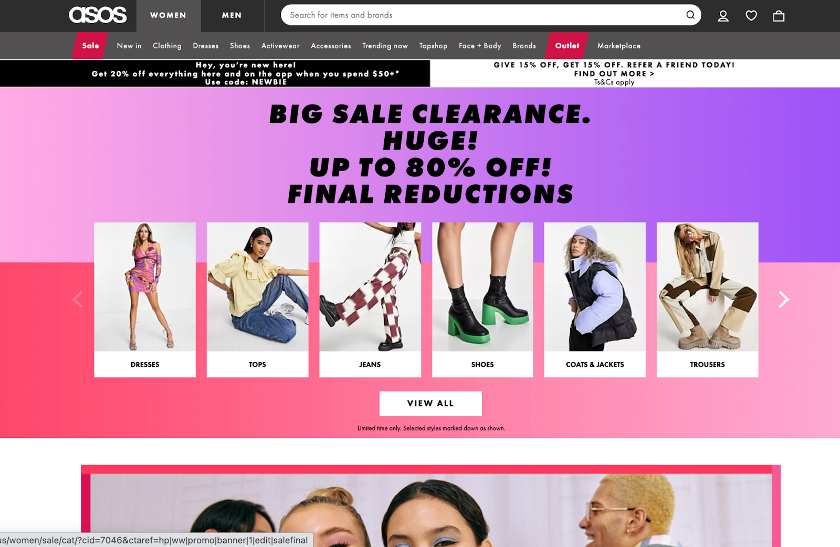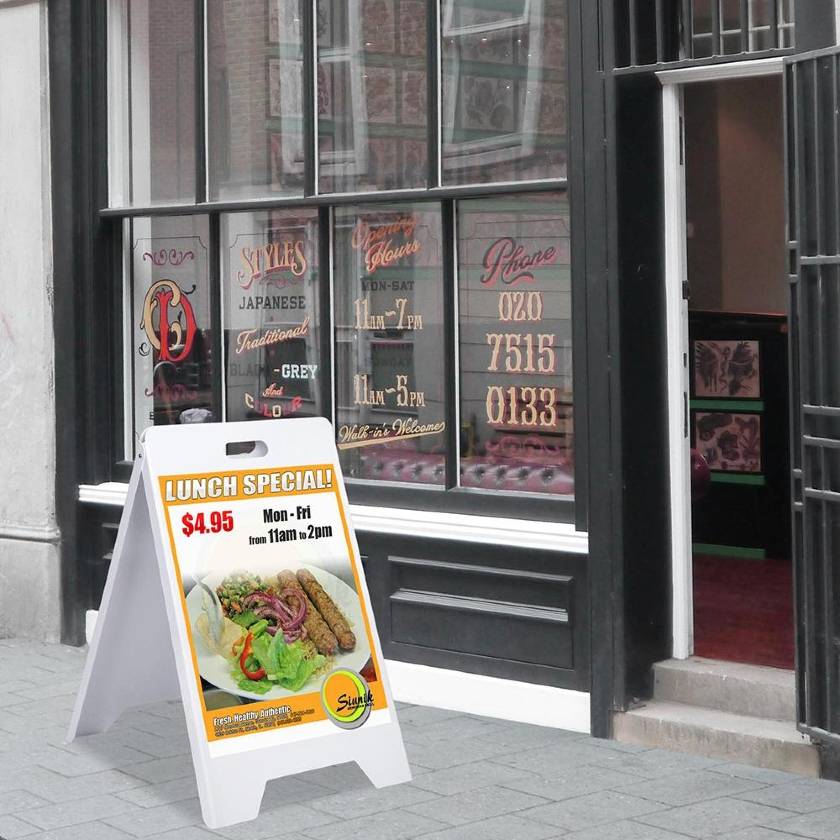Merchandising includes all the non-verbal tactics retailers use for presenting and promoting their goods in-store. This includes your store layout, the products you choose to sell, how you arrange them, and even your pricing strategy. Retailers use merchandising in their stores to cultivate their brand image, improve customer experience, and drive sales.
Merchandising can make or break the success of your retail business. From conversion rates to foot traffic and customer satisfaction—effective merchandising is key to making your store appealing and converting sales.
If you want to see a visual representation of our merchandising guide, check out our video below. Or keep reading to learn more about the essential elements of retail merchandising, its benefits, and how much merchandising should cost.
Elements of Merchandising
Retail merchandising includes different elements that are layered to create a complete merchandising picture in your storefront. These elements include:
- Store layout: The layout of your store acts as a tour guide directing shoppers through all the products you have to offer. Learn more with our resources below:
- Product displays: Create temporary or permanent displays so that you can showcase key products to your customers. Read more:
- Product selection: To motivate shoppers to buy, retailers need to source products that complement each other and create a cohesive brand image. Read more:
- Pricing strategy: Product pricing needs to be high enough to make a good profit, but competitive enough to appeal to shoppers. Retailers also offer promotions to strategically encourage spending. Read more:
- Ecommerce site design: Your business’s online store should also utilize merchandising strategies to create an online store that is compelling and easy to navigate. Read more:
- Exterior merchandising: The way your store looks from the outside will draw in foot traffic and determine shoppers’ first impression of your brand. Read more:
- Loss prevention: Use smart product placement and theft prevention merchandising to avoid lost inventory. Read more:
- Store cleanliness: To keep your store at its best, your merchandising strategy should also entail cleaning practices. Read more with this resource or see our detailed cleaning strategies section below:
- Merchandising upkeep: You merchandising scheme should not be stagnant and should change continuously with different seasons, holidays, events, and inventory. Create a plan for keeping your merchandising fresh so you maintain interest and relevance. Read more in our detailed upkeep section below.
Did you know? Sales and merchandising are very similar; however, they are not the same thing. Merchandising is a tactic used to encourage customer purchases in-store, whereas sales refers to the actual act of making a purchase.
It may sound obvious, but keeping your store neat and tidy is an important part of merchandising that will encourage sales and help to create a good impression on shoppers.
Being attentive to details like sparkling floors and clutter-free checkout counters shows customers that you take pride in how you manage your retail business, and also indicates that you will show them attention and respect. A scuffed floor and dusty corners, on the other hand, show a lack of attention and shoppers will assume that your level of service is equally inattentive.
The best way to maintain a clean store is to adopt a cleaning schedule. To do this, you will want to break your store into zones and assign a different zone for cleaning each day. Keep in mind that some areas—like the entrance and exit, bathrooms, and checkout areas—will need to be cleaned more frequently than others. This resource from DLL Cleaning Service offers a comprehensive downloadable cleaning zone checklist.
In addition to keeping your store clean, updating your merchandising is another important part of store upkeep. But how often should you be updating?
Here is a list of best practices and tips for updating your store merchandising.
- Practice the six-month rule: As a general rule of thumb, redo your store’s space and category allocations every six months. This will encourage regular customers to re-explore your space and be exposed to new products in their normal shopping path.
- Merchandise outside of store hours: Merchandising is a big project that often involves ladders and messes. You want to be sure your store is set up to go once you are open, so keep your merchandising projects to before or after your store is open.
- Update window displays at least monthly: Your window displays are the most visible part of your store and should be changed frequently to attract customers and keep your regular traffic interested.
- Remember the seasons: Most retail stores benefit from incorporating seasonal decor and merchandising into their storefronts, so update your store with the seasons.
- Rotate entrance displays as much as possible: The displays right outside the decompression zones should be rotated frequently and feature your newest products so that even regular customers are hooked as soon as they step foot in your store.
Decompression zone: This is the area directly inside your retail store where customers mentally shift from the world outside to your store environment. It gives customers time to pause, take in displays, get a sense of your brand, and make an initial judgment about your store.
- Weekly refresh: Update things like mannequins, table displays, rack organization, or shelving displays weekly to keep your store fresh. This is a great task to delegate to store associates during their shifts on slower days.
- Observational and analytical inputs: Use an integrated POS system like Lightspeed or observational data to determine what merchandising tactics are working best so that you can implement more effective tactics as you make your updates.
- Create a routine: With all the different pieces of keeping your merchandising fresh, it is helpful to create a routine or schedule so that everything gets done. Assign some tasks to your staff for specific days of the week and hold yourself accountable for the larger initiatives by scheduling established dates and times when you will get them done.
Ecommerce merchandising is the practice of displaying and promoting products on your online store. All the basics of in-store merchandising—layout, design, pricing, and displays—apply to your ecommerce website. And, just like with merchandising your storefront, your online presence should speak to your brand voice and align with your products and customer base.
Here are some effective ecommerce merchandising strategies.
- Clear design: Just like the displays in your store should be thematic and uncluttered, your online presence should be streamlined with minimal sidebars, flashing text, and moving parts so that customers can focus on the products.
- Homepage storytelling: Similar to the window display in your storefront, your homepage will be where customers make their initial judgment about your business. Be sure yours tells your brand story and entices visitors to keep exploring your site.
Display an offer on your homepage. This will help get people interested enough to enter your site and start exploring.
- Special occasion landing pages: For big shopping events, you can create landing pages that are specifically designed to advertise and highlight the big day.

Adding an enticing deal to your homepage can help get people engaged and shopping. (Source: ASOS)
- Simplified path to purchase: Having too many steps during the checkout process leads to abandoned carts, similar to how in-store shoppers might leave if the checkout line is too long. Simplify this process as much as possible and have a status bar at the top indicating how many steps shoppers should expect during checkout.
- Easy navigation: Great in-store merchandising makes it easy for shoppers to find what they are looking for; online shoppers should also be able to find products easily with menu bars showing different product categories and a search function with the ability to sort and filter items.
- Powerful product descriptions: Instead of simply describing each product, your online product description should act as a virtual store associate and detail the benefits of every product.
- Lots of product photos: Give customers peace of mind by offering lots of pictures of the products you are selling. This will help shoppers feel more assured of their purchases and boost buying confidence.
Want to learn more about writing the best product descriptions and taking great product photos? Check out our articles on the top strategies for writing compelling product descriptions and a DIY guide to product photos.
- Integrated membership options: Allow customers to make an account with you to encourage their loyalty, streamline their purchase history, and maintain an ongoing line of communication.
- Banner displays: Adding a banner to the top of your website will allow you to flash deals and messages to your customers no matter what page of your website they are on. This makes it so all your offers are visible when customers are on product pages or making purchasing decisions.

Adding a banner to the top of every page of your website ensures customers see your offers. (Source: Thrive Market)
Benefits of Merchandising
Well-stocked shelves, clear pricing, tidy displays, and smart merchandising strategies promote more customer engagement and product visibility, which will help drive sales. Here are some specific ways merchandising benefits your bottom line.
Merchandising Cost Considerations
The costs associated with merchandising can vary widely but, rest assured, you do not have to break the bank to create a beautifully merchandised storefront.
Did you know? Merchandising is a type of marketing. Marketing refers to all promotional efforts inside and outside of a store, whereas merchandising refers to promotional efforts that happen within a retail store or website.
Before you begin merchandising, you will need to determine your budget. Start with a static budget or the “goal number” that you would like to spend. In addition to this goal figure, give yourself a little space to accommodate unforeseen issues by adding a “flex number” or the maximum you would spend to make things work.
In terms of what those goal and flex numbers should be, the US Small Business Administration has historically recommended spending between 7%–8% of your total revenue on all marketing initiatives, including merchandising. The 2021 CMO Survey suggests marketing budgets for business-to-business (B2B) firms of 6%–8%.
In other words, your merchandising budget will be based on your revenue and should be included in your total marketing budget. The amount of your marketing budget that merchandising should take up will depend on how much payoff it creates, but should not exceed 4% of your annual revenue and no more than 50% of your total marketing budget.
Learn how to predict your upcoming revenue so that you can make a budget that keeps your profitable with our guide, Demand Forecasting in Retail: Models & Why It Is Important.
Money-saving Merchandising Tips
Here is a list of things you should consider and tips to help you stick to your merchandising budget.
- Consider your materials: You can often achieve the same look using different, more cost-effective materials. Some of the least expensive materials you can work with include plexiglass, cardboard, veneer wood, and certain plastic—so get creative and use cost-effective materials within your space. More often than not, if customers can see the look you were going for, they are not going to care whether you are using real mahogany or mahogany veneer.
- DIY: Not everything has to be done by a professional. Use resources like Pinterest or the HGTV website to find DIY projects that will get your hands in the game while saving you money.
- Save and reuse your supplies: Keep track of your decor and fixtures, as you can often reuse them season after season without needing to invest in anything new.
- Order in bulk: Order things like lightbulbs, hardware, and cleaning supplies in bulk to save money and avoid paying shipping fees.
- Stay cohesive: If everything you use for merchandising is on-brand and fits together, you can reuse products over and over again in new ways without having to invest in something new every time.
- Identify investment areas: Be considerate about where you are putting your money. You should spend the most money on the entrance and window displays as these areas will yield the greatest return. The back of your store should have the most minimal merchandising—it benefits the least from flashy displays and decor.
- Hire a professional merchandiser: If it fits in your budget, companies like Retail Merchandising Services are a great resource to help you find the most cost-effective supplies and teach you about economical merchandising solutions from merchandising experts.
- Work with your suppliers: Reach out to your suppliers. They will often offer free temporary POP displays in exchange for featuring their products.
- Install outside of store hours: To avoid costly store closures or disruption for shoppers, do your merchandising installs outside of regular shopping hours.
Merchandising Frequently Asked Questions (FAQ)
Click through the questions below to get answers to some of your most frequently asked merchandising questions.
Merchandising includes all non-verbal strategies that retailers use to sell their products, so an example of merchandising can be anything from the way a product is displayed on a shelf to how much the retailer charges for the item.
Merchandising includes any non-verbal ways that a retailer promotes their products, including how it’s displayed, how much the item costs, what the product is, how well the store is maintained, the product’s online presentation, and more.
Merchandising is essential for driving sales, creating a positive customer experience, and crafting your brand image.
Bottom Line
Merchandising will determine how you use your space, pricing strategies, display techniques, product selection, and much more. Not only that, but smart merchandising choices will help define your brand and customer experience and drive sales. Merchandising is at the heart of your physical space and your customer impressions, and understanding how it works will set you up to create a beautiful store that will keep customers spending and coming back again and again.



